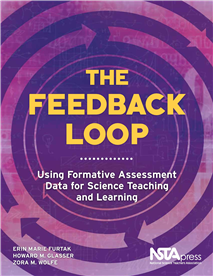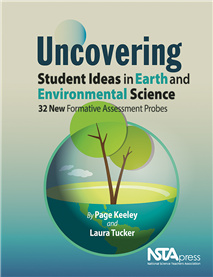All Resources
Book Chapter
This chapter introduces and provides an overview of the Feedback Loop. It explains its structure and usefulness in guiding teachers to consider a number of components when setting goals, developing tools to collect data, and analyzing those data to d...
Book Chapter
This chapter highlights how we think about goals in the Feedback Loop. It discusses the element’s value, explaining what it is and how teachers can use it to grow in their practice and better support student learning. District and state standards ...
Book Chapter
Designing, Selecting, and Adapting Tools
This chapter walks you through processes for selecting, adapting, and designing tools to use in the Feedback Loop. It provides ideas for tools teachers can use to explore selected science practices in classrooms. The tools mentioned include ways to ...
Book Chapter
This final step of the Feedback Loop is where everything comes together. The chapter starts by talking about what we mean by inferences and then walks through a few guides for making those inferences. Also included are some vignettes of teachers maki...
Book Chapter
This chapter explores how to close the loop by connecting inferences and goals through feedback. It presents the process of connecting inferences about student learning back to original goals in the Feedback Loop, a process called identifying the gap...
Book Chapter
Using the Feedback Loop to Plan and Inform Instruction
This chapter uses the full Feedback Loop to describe an approach for planning and informing instruction. It is designed to combine all the information in the previous chapters into a series of resources that will help you learn to use all the element...
Book Chapter
This chapter discusses how to collaborate with colleagues when considering data and the Feedback Loop to further increase the effect this work can have. We discuss the value and importance of working with other educators and identify ways to go abou...
Book Chapter
The purpose of this assessment probe is to elicit students’ ideas about the structure of the solid Earth. The probe is designed to find out if students recognize that Earth’s outer layer (crust) is mostly solid rock with a thin layer of soil on t...
Book Chapter
The purpose of this assessment probe is to elicit students’ ideas about soil. Soil is the material that is useful to plants and animals, including people. Its formation is a slow process but continuous and still happening today. This probe is desig...
Book Chapter
The purpose of this assessment probe is to elicit students’ ideas about the surface of Earth. It is designed to find out if students recognize that most of Earth’s surface is covered by water and helps students learn about the ratio of water to l...
Book Chapter
Where is Most of the Fresh Water?
The purpose of this assessment probe is to elicit students’ ideas about the distribution of fresh water. The probe is designed to find out if students recognize that most of Earth’s fresh water is found in frozen form or groundwater. It is best u...
Book Chapter
The purpose of this assessment probe is to elicit students’ ideas about a major freshwater resource, groundwater. The probe is designed to find out how students visualize groundwater, which can be challenging as it is very different from water reso...
Book Chapter
The purpose of this assessment probe is to elicit students’ ideas about the ocean and seas. The probe is designed to reveal whether students use geographic names and locations to consider the number of separate oceans and seas or use the concept of...
Book Chapter
The purpose of this assessment probe is to elicit students’ ideas about the ocean’s salinity. This probe is best used with grades 5–12, and is designed to uncover students’ ideas about the role of landforms and rivers in carrying salt into th...
Book Chapter
The purpose of this assessment probe is to elicit students’ ideas about the water cycle. The probe is designed to find out what students think a representation of the water cycle should include to show evaporation and transpiration. This probe is b...
Book Chapter
Where Did the Water in the Puddle Go?
The purpose of this assessment probe is to elicit students’ ideas about evaporation. The probe is designed to find out if students recognize that water goes into the air around us in the form of water vapor. It is best used with grades 3–8, and c...
Book Chapter
The purpose of this assessment probe is to elicit students’ ideas about weather predictions. The probe is designed to find out if students recognize the limitations of long-term weather forecasting and to help students understand the difference bet...
Book Chapter
In Which Direction Will the Water Swirl?
The purpose of this assessment probe is to elicit students’ ideas about the Coriolis effect, which describes how rotating objects are deflected and helps explain the movement of large fluid masses. The probe is designed to find out whether students...
Book Chapter
Does the Ocean Influence Our Weather or Climate?
The purpose of this assessment probe is to elicit students’ ideas about the connection between the oceans and weather and climate. The probe is designed to reveal how students think the ocean influences atmospheric conditions. Of all the influences...
Book Chapter
The purpose of this assessment probe is to elicit students’ ideas about weather versus climate. The probe is designed to find out if students distinguish between a one-time weather-related change and a change in climate. Weather and climate are rel...
Book Chapter
Are They Talking About Climate or Weather?
The purpose of this assessment probe is to elicit students’ ideas about climate. The probe is designed to find out whether students distinguish between weather and climate. It is important that students understand that they are to select statements...
Book Chapter
What Are the Signs of Global Warming?
The purpose of this assessment probe is to elicit students’ ideas about signs of global warming. The probe is designed to determine whether students think a statement is accurate or complete enough to see direct patterns or draw inferences from dat...
Book Chapter
The purpose of this assessment probe is to elicit students’ ideas about Earth’s history. The probe is designed to reveal how old students think Earth is. It is important that students include in their explanation the type of evidence they think s...
Book Chapter
Fossils provide evidence about the types of organisms that lived long ago and also about the nature of their environments. The purpose of this assessment probe is to elicit students’ ideas about fossils. The probe is designed to find out if stude...
Book Chapter
The purpose of this assessment probe is to elicit students’ ideas about layers of sedimentary rock. The probe is designed to find out how students think about the age of rock layers. It is best used with grades 6–12, and students should be famili...
Book Chapter
The purpose of this assessment probe is to elicit students’ ideas about erosion. The probe is designed to find out whether students can distinguish between erosion and weathering. When rock material is broken down or changed, but not transported to...
Book Chapter
The purpose of this assessment probe is to elicit students’ ideas about weathering. The probe is designed to find out whether students recognize that plants, including small plants, can cause weathering of rock. Plant roots as they grow larger can ...
Book Chapter
The purpose of this assessment probe is to elicit students’ ideas about the formation of the Grand Canyon and is specific to the Grand Canyon. The probe is designed to find out if students recognize the role of rivers and flowing water and connect...
Book Chapter
The purpose of this assessment probe is to elicit students’ ideas about processes that change Earth. The probe is designed to find out if students recognize that the sand on many beaches results from weathering of rock on mountains, erosion, and de...
Book Chapter
The purpose of this assessment probe is to elicit students’ ideas about rivers. The probe is designed to find out how students think most rivers formed and can be used with grades 3–12. It is helpful to show a photograph of a river when presentin...
Book Chapter
What is the Inside of Earth Like?
The purpose of this assessment probe is to elicit students’ ideas about Earth’s structure. The probe is designed to find out if students recognize Earth’s interior is made up of layers and is mostly solid. It is best used with grades 6–12. As...
Book Chapter
The purpose of this assessment probe is to elicit students’ ideas about Earth’s tectonic plates. The probe is designed to uncover commonly held misconceptions about Earth’s plates. Plate tectonics is the unifying theory that explains the past a...
Book Chapter
Where Do You Find the Earth’s Plates?
The purpose of this assessment probe is to elicit students’ ideas about Earth’s plates. The probe is designed to find out where students think tectonic plates are located. Earth is composed of several major, large tectonic plates and several smal...
Book Chapter
What Do You Know About Volcanoes and Earthquakes?
The purpose of this assessment probe is to elicit students’ ideas about plate tectonic features and events. The probe is designed to uncover commonly held misconceptions about volcanoes and earthquakes. If students believe that earthquakes usually ...
Book Chapter
The purpose of this assessment probe is to elicit students’ ideas about Earth’s natural resources. The probe is designed to find out if students can distinguish between renewable and nonrenewable natural resources. It is important students know t...
Book Chapter
The purpose of this assessment probe is to elicit students’ ideas about pollution. The probe is designed to uncover commonly held ideas about acid rain, which is caused when normal rain combines with things in the air that come from pollution. This...
Book Chapter
The purpose of this assessment probe is to elicit students’ ideas about watersheds. A watershed is an area of land where all of the water that is under it or drains off of it goes into the same place. They come in all shapes and sizes and include b...
Book Chapter
The purpose of this assessment probe is to elicit students’ ideas about natural versus human-engineered products. This probe is designed to uncover whether students think natural always means not harmful while some can be quite toxic, not only to i...
Book Chapter
The purpose of this assessment probe is to elicit students’ ideas about the greenhouse effect. The probe is designed to reveal whether students confuse the greenhouse effect with other environmental concerns or lump the concerns together. The green...
Book Chapter
Science Learning in the Early Years (Sample Chapter)
At first glance, you can see the value of Science Learning in the Early Years because it provides you with both 40-plus classroom activities and an understanding of how to use them with young students. The book shows you how to go beyond demonstratio...





